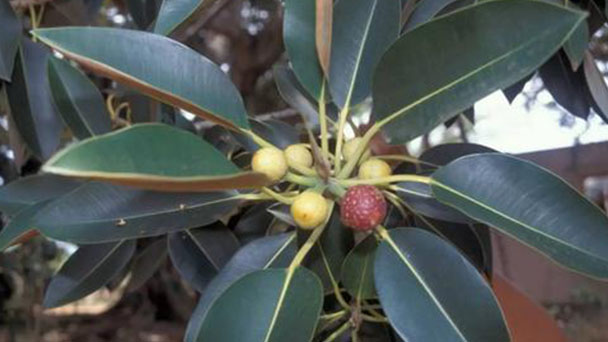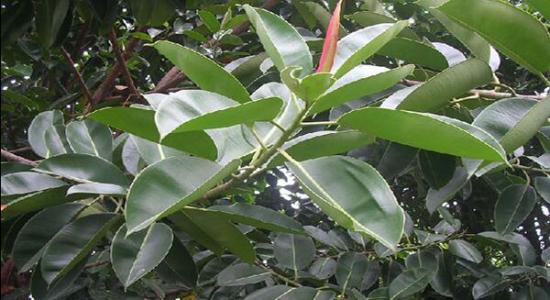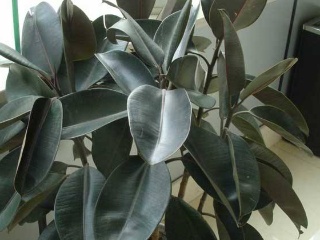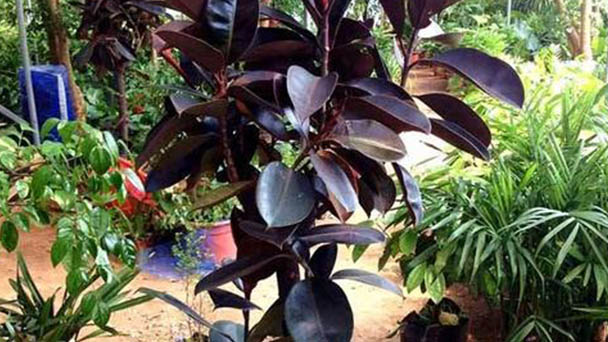Rubber fig care tips
Written by Maggie
Oct 29 2021

Rubber fig could be the ideal houseplant for you if you want a tough but easy going indoor plant that can reach staggering heights within just a few years. Here are some tips for growing Rubber fig.

Rubber Fig - Most Common House Plant
How to care for Rubber fig leaves having yellow spots
Rubber fig leaves yellow spot is mainly caused by disease, usually based on carbon and jaundice disease resistance. It is best to plant disease leaves cut down on concentrated destruction, spraying the right amount of carbon jaundice beauty solution or carbendazim solution for prevention and control at the same time during the period of growth for the appropriate clip. Cut off deadwood rotten leaves early, air circulation should be strengthened in order to reduce the harm of diseases and pests.
1. Control carbon jaundice
Carbon jaundice disease is rubber fig the most common disease. It’s harm is bigger. That's one reason why there are so many little yellow spots on the leaves of Rubber fig. In the later stages of the disease, the yellow dots gradually spread into round black spots. In severe cases, the plants will wither and die. It's best to get rid of the diseased leaves above. The corresponding carbon jaundice fumei solution was sprayed for prevention and treatment.
2. Control gray spot disease
Grey plaque is also a common fungal disease on Rubber fig. It occurs mostly on branches or leaves. In the early stage of the disease will appear a lot of small yellow points, and later it will gradually expand into irregular shape, leaves will naturally wilt and yellow. In order to reduce the hand damage of leaves, it is better to cut off the diseased leaves and destroy them in a centralized manner, spraying carbendazim solution in time for prevention and control.
3. Pruning
In the process of growing Rubber fig, the growth of plants should be observed frequently. During the growth period, concentrated pruning of dead branches and rotten leaves on the plants should be carried out. Some branches with poor growth or too many branches should be combed and cut, but it is not suitable for heavy pruning. After pruning, impurities on the soil should be cleaned so as not to pollute the growth environment of Rubber fig.
4. Strengthen ventilation for Rubber fig
In order to ensure the normal growth and development of Rubber fig, it is better to strengthen the air circulation during the growth period, especially in the season of high temperature and humidity. Rubber fig should not be kept in a closed environment for too long. Meanwhile, it should not be watered too much to prevent water in the potted soil, otherwise diseases will easily occur and adversely affect the growth of plants.

Rubber fig is one of the best trees for pots
How to care for Rubber fig too thin and tall
Rubber fig likes the sun. If the Rubber fig is thin and tall, First of all, it needs to be moved to the mild sun and carefully maintained, and the long part needs to be trimmed. And also the top of the bud for shortcut core processing. If lack of nutrients leads to thinness and height, then fertilizer should be applied promptly. As a result of soil discomfort, soil hardening and other problems, leaf-rotting soil and garden soil should be used for matrix curing of Rubber FIG immediately.
1. Plenty of sunshine for Rubber fig
The thin and high Rubber fig may be caused by the lack of light, so it is necessary to move it immediately to the full sunshine for curing. With the help of sunlight, it can resist the growth of Rubber fig, and also help the Rubber fig absorb nutrients in the soil, so that the growth of Rubber fig can be more ornamental.
2. Cut Rubber fig short
Whenever the growth of Rubber fig is thin and high, it is not only necessary to move it to the sun in time for careful curing, but also to cut off its excessively long branches and leaves, and remove the buds on the top of Rubber fig, which can concentrate nutrients in the soil and promote the growth of rubber fig tree to be stronger.
3. Fertilizer application of Rubber fig
In fact, it is necessary to provide sufficient nutrients, if not enough nutrients will make it thin and high, so what should be done with thin and high Rubber fig? Not only should it be timely pruned, but also nitrogen and phosphate fertilizer should be applied in time. Normally, it is necessary to apply fertilizer every 15-20 days during the growth period, which is conducive to the growth of Rubber fig.
4. Turn the pot and change the soil for Rubber fig
If Rubber fig is thin and tall, it may also be caused by soil discomfort, soil hardening and other problems. It is necessary to immediately turn over the basin, replace the soil and maintain it carefully. Generally, leaf-rotting soil and garden soil can be mixed as the substrate for breeding Rubber FIG. Such soil can provide sufficient nutrients and moisture to make it grow well.

Rubber Fig - one of the best indoor trees
Read Next: Rubber Tree Plant (Rubber Fig) Care & Growing Guide
Latest Updated
- Benefits of Bugleweed - 7 Science-backed Health Benefits
- Bugleweed Dangers & Side Effects - Is It Poisonous?
- How to Plant Evergreen Trees - What You Should Know
- When to Plant Evergreens - Grow Guide for Evergreen Trees
- 12 Wonderful Evergreen Shrubs for Your Garden
- 12 Popular Evergreen Plants with Pictures for Beginners
- When And How To Prune A Lilac Bush Like a Pro
- How to Grow & Care for Lilac Vine (Hardenbergia Violacea)
- Japanese Lilac Tree (Syringa Reticulata) Care & Propagation Guide
- Shumard Oak Pros and Cons - What to Know
Popular Articles
- Winter maintenance of Antirrhinum Majus
- How to Grow Terminalia Mantaly Tree
- How to Grow and Care for Crossostephium Chinense
- How to grow Antirrhinum Majus in spring
- Peristeria Elata (Dove Orchid) Profile: Info & Care Guide
- Underwatered Snake Plant (Sansevieria Trifasciata) - Signs And How To Fix
- How to Care for Brazilian Jasmine Plant (Mandevilla Sanderi)
- How to Grow & Care for Graptopetalum Purple Delight in Summer
- Rosa Chinensis (China Rose): Plant Growing & Care Tips
- How to Care for Baby Sun Rose (Aptenia Cordifolia)